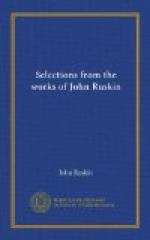How so debased a law ever came to be established, we shall see when we come to describe the Renaissance schools; here we have only to note, as the second most essential element of the Gothic spirit, that it broke through that law wherever it found it in existence; it not only dared, but delighted in, the infringement of every servile principle; and invented a series of forms of which the merit was, not merely that they were new, but that they were capable of perpetual novelty. The pointed arch was not merely a bold variation from the round, but it admitted of millions of variations in itself; for the proportions of a pointed arch are changeable to infinity, while a circular arch is always the same. The grouped shaft was not merely a bold variation from the single one, but it admitted of millions of variations in its grouping, and in the proportions resultant from its grouping. The introduction of tracery was not only a startling change in the treatment of window lights, but admitted endless changes in the interlacement of the tracery bars themselves. So that, while in all living Christian architecture the love of variety exists, the Gothic schools exhibited that love in culminating energy; and their influence, wherever it extended itself, may be sooner and farther traced by this character than by any other; the tendency to the adoption of Gothic types being always first shown by greater irregularity, and richer variation in the forms of the architecture it is about to supersede, long before the appearance of the pointed arch or of any other recognizable outward sign of the Gothic mind.
We must, however, herein note carefully what distinction there is between a healthy and a diseased love of change; for as it was in healthy love of change that the Gothic architecture rose, it was partly in consequence of diseased love of change that it was destroyed. In order to understand this clearly, it will be necessary to consider the different ways in which change and monotony are presented to us in nature; both having their use, like darkness and light, and the one incapable of being enjoyed without the other: change being most delightful after some prolongation of monotony, as light appears most brilliant after the eyes have been for some time closed.
I believe that the true relations of monotony and change may be most simply understood by observing them in music. We may therein notice first, that there is a sublimity and majesty in monotony, which there is not in rapid or frequent variation. This is true throughout all nature. The greater part of the sublimity of the sea depends on its monotony; so also that of desolate moor and mountain scenery; and especially the sublimity of motion, as in the quiet, unchanged fall and rise of an engine beam. So also there is sublimity in darkness which there is not in light.




